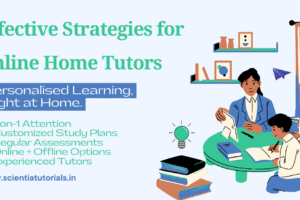Breaking Through Barriers: Teaching Tips for Home Tutors on Helping Students Overcome Learning Plateaus
Introduction
Learning plateaus can be a frustrating experience for students and tutors alike. These phases, characterized by a noticeable halt in progress despite consistent effort, can undermine students’ motivation and self-confidence. As a home tutor, recognizing and addressing these plateaus is crucial for fostering a positive learning environment and ensuring academic success. This article provides practical strategies and teaching tips for home tutors to help students break through learning plateaus and reignite their passion for learning.
Understanding Learning Plateaus
Before diving into strategies for overcoming learning plateaus, it’s essential to understand what they are and why they occur.
- Definition: A learning plateau is a phase where a student experiences little to no improvement in their understanding or performance in a particular subject or skill.
- Common Causes:
- Repetition and Routine: Students may become bored with repetitive tasks and lessons.
- Inadequate Challenge: If the material is too easy, students may disengage.
- Overwhelm: Conversely, if the content is too difficult, students may feel frustrated and give up.
- Lack of Motivation: External factors such as personal issues, fatigue, or stress can impact a student’s ability to learn effectively.
Recognizing these factors is the first step toward helping students move past these plateaus.
Strategies for Overcoming Learning Plateaus
1. Identify the Root Cause
Understanding why a student has hit a plateau is crucial. Here’s how to approach this:
- Conduct a Discussion: Sit down with your student and ask open-ended questions about their feelings toward the subject. Questions like “What do you find challenging?” or “What areas do you feel stuck in?” can provide valuable insights.
- Analyze Performance Data: Review recent assessments and assignments to identify patterns. Is the student consistently struggling with specific topics or skills?
- Observe Engagement Levels: Pay attention to the student’s behavior during lessons. Are they distracted, frustrated, or disengaged? This can offer clues to underlying issues.
2. Adjust Teaching Methods
Once you’ve identified the root cause, it’s time to modify your approach. Here are some techniques:
- Vary Instructional Techniques: If a student is bored, introduce new teaching methods such as hands-on activities, multimedia resources, or group discussions. Variety can stimulate interest and engagement.
- Incorporate Different Learning Styles: Understand the student’s preferred learning style (visual, auditory, kinesthetic) and tailor your lessons accordingly. For instance, if a student is a visual learner, use diagrams, videos, or visual aids.
- Use Real-World Applications: Show students how the material relates to real-life scenarios. This connection can make learning more relevant and exciting.
3. Set Achievable Goals
Goal setting is an effective way to motivate students and help them see progress. Here’s how to implement this strategy:
- SMART Goals: Encourage students to set SMART (Specific, Measurable, Achievable, Relevant, Time-bound) goals. For instance, instead of saying, “I want to get better at math,” a student could say, “I want to improve my algebra skills by completing five practice problems every day for the next week.”
- Break Down Larger Goals: Large goals can be overwhelming. Break them into smaller, manageable tasks that can be accomplished in a shorter time frame.
- Celebrate Milestones: Acknowledge and celebrate when students achieve their goals, no matter how small. This recognition boosts motivation and reinforces positive behavior.
4. Incorporate Regular Assessments
Frequent assessments can help identify areas where students are struggling and provide opportunities for growth:
- Formative Assessments: Use quizzes, quick tests, or informal assessments to gauge understanding and track progress. This will help you adjust your teaching strategies accordingly.
- Self-Assessments: Encourage students to assess their own understanding of the material. This reflection can help them identify areas where they feel confident and areas that require more attention.
- Feedback Mechanisms: Provide constructive feedback on assignments and assessments. Highlight strengths while also addressing areas for improvement.
5. Foster a Growth Mindset
A growth mindset encourages students to view challenges as opportunities for growth. Here’s how to cultivate this mindset:
- Encourage Positive Self-Talk: Teach students to replace negative thoughts with positive affirmations. Phrases like “I can improve with practice” or “Mistakes help me learn” can foster resilience.
- Share Stories of Perseverance: Share stories of individuals who have overcome challenges through persistence and hard work. This can inspire students and help them understand that plateaus are a normal part of the learning process.
- Focus on Effort: Reinforce the importance of effort over innate ability. Celebrate the process of learning rather than just the end results.
6. Create a Supportive Learning Environment
A positive and supportive environment is crucial for student success:
- Encourage Open Communication: Foster an atmosphere where students feel comfortable discussing their struggles and frustrations. Being able to express their feelings can alleviate pressure and anxiety.
- Build Trust: Establish a trusting relationship by showing empathy and understanding. When students feel valued and supported, they are more likely to take risks and push through challenges.
- Incorporate Collaborative Learning: Encourage collaboration with peers. Group activities can foster camaraderie, making learning feel less isolating and more enjoyable.
Utilizing Technology to Enhance Learning
Technology can play a significant role in helping students overcome learning plateaus:
- Online Resources: Introduce students to online platforms like Khan Academy, Coursera, or educational YouTube channels that provide additional explanations and practice materials.
- Interactive Learning Tools: Utilize interactive tools and apps that encourage engagement, such as Quizlet for flashcards or Duolingo for language learning.
- Gamification: Incorporate gamified learning experiences to make lessons more enjoyable. This can involve using educational games or platforms that turn learning into a competitive yet fun experience.
The Role of Parents in Supporting Learning
Engaging parents in the learning process can help reinforce the strategies you implement as a tutor:
- Regular Updates: Keep parents informed about their child’s progress and the strategies you are using to address learning plateaus.
- Encourage Involvement: Suggest ways parents can support their child at home, such as creating a study schedule, providing a conducive study environment, or encouraging positive habits.
- Share Resources: Provide parents with resources that can help them support their child’s learning, such as articles, websites, or books related to effective study habits.
Conclusion
Learning plateaus are a natural part of the educational journey, but they don’t have to hinder a student’s progress. As a home tutor, your role is vital in recognizing these plateaus and implementing effective strategies to help students overcome them. By identifying root causes, adjusting teaching methods, setting achievable goals, fostering a growth mindset, and involving parents, you can empower your students to break through barriers and achieve their academic potential. With patience, creativity, and persistence, you can guide your students towards renewed motivation and success in their learning journey.



